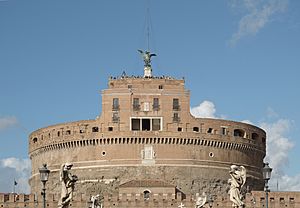Hadrian's Mausoleum facts for kids
The Mausoleum of Hadrian, now known as Castel Sant'Angelo, is a huge round building in Rome, Italy. It was first built as a special tomb for the Roman emperor Hadrian and his family. Later, it became a strong fortress and castle for the popes. Today, it is a popular museum. This amazing structure was once the tallest building in Rome!
Contents
What is Castel Sant'Angelo?
Castel Sant'Angelo is a very old and important building in Rome. It stands tall next to the Tiber River. Its history goes back almost 2,000 years. It has changed its purpose many times over the centuries.
From a Tomb to a Fortress
Emperor Hadrian ordered this building to be made as a mausoleum. A mausoleum is a grand and impressive tomb. It was finished in 139 AD, after Hadrian had passed away. His ashes and those of his family were placed inside.
Over time, Rome faced many attacks. The building was so strong that it was turned into a military fortress. It became a key part of Rome's defenses. Later, the popes used it as a castle. They even built a secret passage to it from St. Peter's Basilica. This passage allowed them to escape safely during danger.
The Angel on Top
The name "Castel Sant'Angelo" means "Castle of the Holy Angel." This name comes from a legend. In the 6th century, a terrible plague hit Rome. Pope Gregory I saw Archangel Michael on top of the castle. The angel was putting away his sword. This was seen as a sign that the plague would end.
To remember this event, a statue of Archangel Michael was placed on the very top. The current bronze statue was made in 1753. It shows Michael with his sword put away.
A Museum Today
Today, Castel Sant'Angelo is no longer a tomb or a fortress. It is a national museum. Visitors can explore its many rooms and passages. You can see ancient Roman parts and later additions. There are also great views of Rome from the top. It is a fascinating place to learn about Roman history.
Images for kids
-
Castel Sant'Angelo from the bridge. The top statue is of Michael the Archangel, the angel from whom the building derives its name.
-
Bronze statue of Michael the Archangel, standing on top of the Castel Sant'Angelo, modelled in 1753 by Peter Anton von Verschaffelt (1710–1793).
See also
 In Spanish: Castillo de Sant%27Angelo para niños
In Spanish: Castillo de Sant%27Angelo para niños










